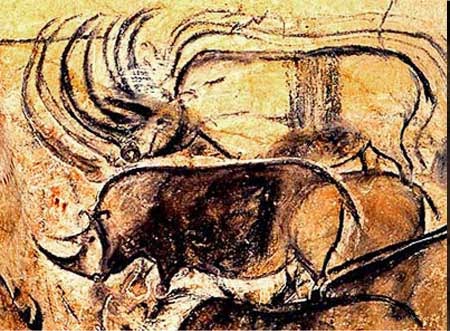Prehistoric cave art at Dordogne, France
At some point in remote prehistory, roughly 12,000 years ago, a group
of men and women – no more than half a dozen, scientists believe –
crawled into the labyrinth of Rouffignac cavern
in the Dordogne's Vézère valley. Once in its deepest recess, they lay
on their backs and, in flickering candlelight, started painting on the
rock ceiling 3ft above them. More than 60 images of mammoths, horses and
ibex were outlined, each animal depicted in simple, confident lines
that reveal startling artistic talent.
This is the Great Ceiling of Rouffignac, one of the world's oldest and most beautiful art galleries. We have few clues as to who created it, though it was probably the work of the Cro-Magnons, the first members of Homo sapiens to settle in Europe 45,000 years ago and survivors of the Ice Age that later gripped the continent. Nor do we know why these artists picked such an inaccessible spot to display their genius – though fortunately it can be reached easily today. A tiny electric train runs from Rouffignac's entrance to the Great Ceiling, the floor of which has been lowered to allow visitors to gaze up at its wonders.
It is a stunning experience, one of many to be found in this remarkable locale. In the 25km of the Vézère valley between Montignac and Les Eyzies there are 15 caves – including Rouffignac, Lascaux and others – which have been rated Unesco World Heritage sites because of their prehistoric art. If you want to understand the minds of our forebears, and appreciate the critical role that art has played in our evolution then the Vézère is for you.
The Chauvet-Pont-d’Arc Cave
The Chauvet-Pont-d’Arc Cave in the Ardèche department of southern France is a cave that contains some of the earliest known cave paintings, as well as other evidence of Upper Paleolithic life. It is located near the commune of Vallon-Pont-d’Arc on a limestone cliff above the former bed of the Ardèche River, in the Gorges de l’Ardèche. Discovered on December 18, 1994, it is considered one of the most significant prehistoric art sites.
Hundreds of animal paintings have
been catalogued, depicting at least 13 different species, including
some rarely or never found in other ice age paintings. Rather than
depicting only the familiar herbivores that predominate in Paleolithic
cave art, i.e. horses, cattle, mammoths, etc., the walls of the Chauvet
Cave feature many predatory animals, e.g., cave lions, panthers, bears,
and cave hyenas.
The artists who produced these unique paintings used techniques rarely found in other cave art. Many of the paintings appear to have been made only after the walls were scraped clear of debris and concretions, leaving a smoother and noticeably lighter area upon which the artists worked. Similarly, a three-dimensional quality and the suggestion of movement are achieved by incising or etching around the outlines of certain figures. The art is also exceptional for its time for including “scenes”, e.g., animals interacting with each other; a pair of woolly rhinoceroses, for example, are seen butting horns in an apparent contest for territory or mating rights.
The cave was first explored by a group of three speleologists: Eliette Brunel-Deschamps, Christian Hillaire, and Jean-Marie Chauvet for whom it was named. Chauvet (1996) has a detailed account of the discovery. In addition to the paintings and other human evidence, they also discovered fossilized remains, prints, and markings from a variety of animals, some of which are now extinct. Further study by French archaeologist Jean Clottes has revealed much about the site. The dates have been a matter of dispute but a study published in 2012 supports placing the art in the Aurignacian period, approximately 30,000–32,000 BP.
From Chauvet Cave Wikipedia




